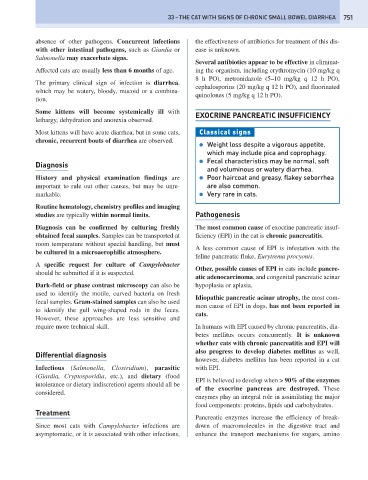Page 759 - Problem-Based Feline Medicine
P. 759
33 – THE CAT WITH SIGNS OF CHRONIC SMALL BOWEL DIARRHEA 751
absence of other pathogens. Concurrent infections the effectiveness of antibiotics for treatment of this dis-
with other intestinal pathogens, such as Giardia or ease is unknown.
Salmonella may exacerbate signs.
Several antibiotics appear to be effective in eliminat-
Affected cats are usually less than 6 months of age. ing the organism, including erythromycin (10 mg/kg q
8 h PO), metronidazole (5–10 mg/kg q 12 h PO),
The primary clinical sign of infection is diarrhea,
cephalosporins (20 mg/kg q 12 h PO), and fluorinated
which may be watery, bloody, mucoid or a combina-
quinolones (5 mg/kg q 12 h PO).
tion.
Some kittens will become systemically ill with
EXOCRINE PANCREATIC INSUFFICIENCY
lethargy, dehydration and anorexia observed.
Most kittens will have acute diarrhea, but in some cats, Classical signs
chronic, recurrent bouts of diarrhea are observed.
● Weight loss despite a vigorous appetite,
which may include pica and coprophagy.
● Fecal characteristics may be normal, soft
Diagnosis
and voluminous or watery diarrhea.
History and physical examination findings are ● Poor haircoat and greasy, flakey seborrhea
important to rule out other causes, but may be unre- are also common.
markable. ● Very rare in cats.
Routine hematology, chemistry profiles and imaging
studies are typically within normal limits. Pathogenesis
Diagnosis can be confirmed by culturing freshly The most common cause of exocrine pancreatic insuf-
obtained fecal samples. Samples can be transported at ficiency (EPI) in the cat is chronic pancreatitis.
room temperature without special handling, but must
A less common cause of EPI is infestation with the
be cultured in a microaerophilic atmosphere.
feline pancreatic fluke, Eurytrema procyonis.
A specific request for culture of Campylobacter
Other, possible causes of EPI in cats include pancre-
should be submitted if it is suspected.
atic adenocarcinoma, and congenital pancreatic acinar
Dark-field or phase contrast microscopy can also be hypoplasia or aplasia.
used to identify the motile, curved bacteria on fresh
Idiopathic pancreatic acinar atrophy, the most com-
fecal samples. Gram-stained samples can also be used
mon cause of EPI in dogs, has not been reported in
to identify the gull wing-shaped rods in the feces.
cats.
However, these approaches are less sensitive and
require more technical skill. In humans with EPI caused by chronic pancreatitis, dia-
betes mellitus occurs concurrently. It is unknown
whether cats with chronic pancreatitis and EPI will
also progress to develop diabetes mellitus as well,
Differential diagnosis
however, diabetes mellitus has been reported in a cat
Infectious (Salmonella, Clostridium), parasitic with EPI.
(Giardia, Cryptosporidia, etc.), and dietary (food
EPI is believed to develop when > 90% of the enzymes
intolerance or dietary indiscretion) agents should all be
of the exocrine pancreas are destroyed. These
considered.
enzymes play an integral role in assimilating the major
food components: proteins, lipids and carbohydrates.
Treatment
Pancreatic enzymes increase the efficiency of break-
Since most cats with Campylobacter infections are down of macromolecules in the digestive tract and
asymptomatic, or it is associated with other infections, enhance the transport mechanisms for sugars, amino

